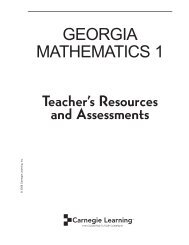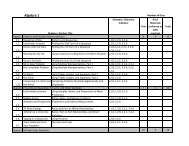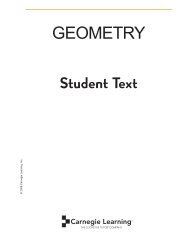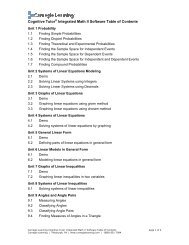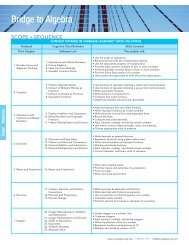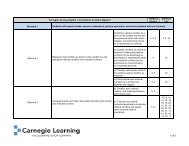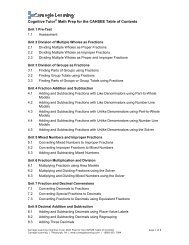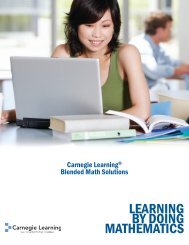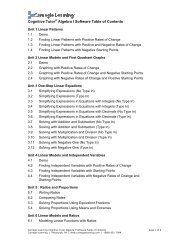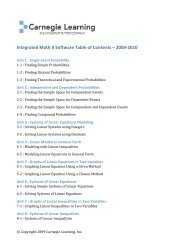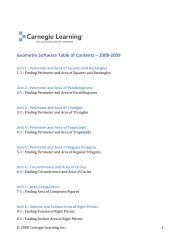IN_Standards for printing.xlsx - Carnegie Learning
IN_Standards for printing.xlsx - Carnegie Learning
IN_Standards for printing.xlsx - Carnegie Learning
You also want an ePaper? Increase the reach of your titles
YUMPU automatically turns print PDFs into web optimized ePapers that Google loves.
G.2.9<br />
G.2.10<br />
G.2.11<br />
Indiana Geometry<br />
Prove and apply theorems about parallelograms and trapezoids<br />
(including isosceles trapezoids) involving their angles, sides, and<br />
diagonals and prove that given quadrilaterals are parallelograms,<br />
rhombuses, rectangles, squares, or trapezoids (as appropriate).<br />
Triangles<br />
Define, identify, construct, and solve problems involving<br />
perpendicular bisectors, angle bisectors, medians and altitudes<br />
in triangles.<br />
Construct triangles congruent to given triangles, explaining and<br />
justifying the process used.<br />
<strong>Carnegie</strong> <strong>Learning</strong> Source 1<br />
Text<br />
Software<br />
9.2, 9.3, 9.4<br />
5.6, 5.7<br />
<strong>Carnegie</strong> <strong>Learning</strong> Resource Center:<br />
Triangle Constructions<br />
G.2.12<br />
Use theorems to show whether two triangles are congruent (SSS,<br />
SAS, ASA) or similar (AA, SAS, SSS).<br />
7.2, 7.3, 8.1, 8.2, 8.3, 8.4, 8.5<br />
G.2.13 Apply the triangle inequality theorem. 3.5<br />
G.2.14<br />
Develop simple geometric proofs involving triangles and provide<br />
reasons <strong>for</strong> each statement.<br />
3.3, 3.4, 3.5, 5.4, 5.5, 5.6, 5.7 14, 15<br />
Isosceles Triangles<br />
G.2.15 Prove and apply the isosceles triangle theorem and its converse. 4.3 17<br />
Right Triangles<br />
G.2.16<br />
G.2.17<br />
G.2.18<br />
G.2.19<br />
G.2.20<br />
Prove the Pythagorean Theorem and its converse and use them<br />
to solve problems, including problems involving the length of a<br />
segment in the coordinate plane.<br />
Prove and apply the relationships that exist when the altitude is<br />
drawn to the hypotenuse of a right triangle.<br />
Use special right triangles (30° ‐ 60° and 45° ‐ 45°) to solve<br />
problems.<br />
Define and use the trigonometric functions (sine, cosine,<br />
tangent) in terms of angles of right triangles.<br />
Deduce and apply the area <strong>for</strong>mula A =1/2 ab sinC, where a and<br />
b are the lengths of two sides of a triangle and C is the measure<br />
of the included angle <strong>for</strong>med by the two sides.<br />
4.2 16<br />
8.4<br />
4.3, 4.4 17<br />
11.1, 11.2, 11.3, 11.4 29<br />
G.2.21<br />
G.3.1<br />
G.3.2<br />
Solve problems that can be modeled using right triangles,<br />
including problems that can be modeled using trigonometric<br />
functions. Interpret the solutions, and determine whether the<br />
solutions are reasonable, using technology as when appropriate.<br />
Standard 3 Circles<br />
Construct the circle that passes through three given points not<br />
on a line and construct tangents to circles and circumscribe and<br />
inscribe circles, justifying the processes used.<br />
Define, deduce and use <strong>for</strong>mulas <strong>for</strong>, and prove theorems <strong>for</strong><br />
radius, diameter, chord, secant, and tangent.<br />
11.1, 11.2, 11.3, 11.4 29<br />
10.2, 10.4, 10.5, 12.1<br />
10.1 27




